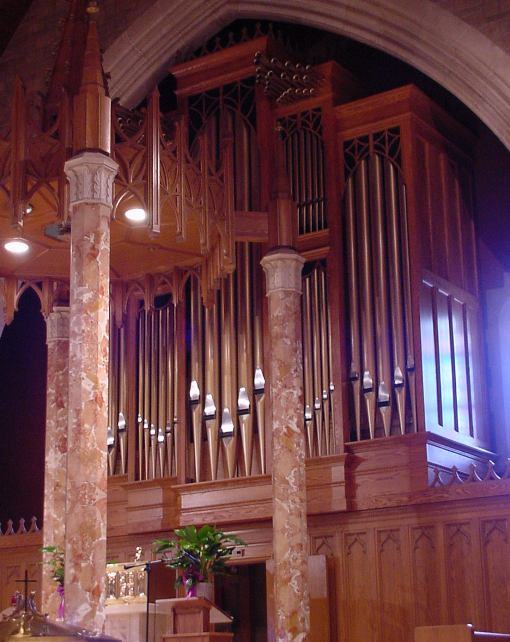5301 Main Street, Trumbull, CT Get directions Visit Website

The organ is of three manual and pedal design and contains 38 ranks of pipework with a total of 2296 speaking pipes. The placement of the organ casework on the central axis of the church projects the tonal resources of the instrument evenly and effectively throughout the nave. The movable low-profile keydesk, in the French curved terrace style, ensures that the organist enjoya excellent sight lines with the choir, cantor and celebrant at all times.
The Grand-Orgue contains the Principal chorus and is positioned high in the casework. A complete Cornet decompose of flutes is also available. A French Flûte Harmonique, scaled in the Cavaille-Coll tradition, provides a beautiful solo voice while the chorus reeds serve to cap the division. The Positif is enclosed in the lower left portion of the casework. This expressive division includes a secondary Principal chorus to serve as a foil to the Grand-Orgue. The Flute Celestes provide a soft velvety quality so useful in worship. The Récit is located in the lower right side of the casework – positioned and designed to accompany the choir in the right transept area. Large pomposa scaled strings and a full reed chorus provide the warmth and power to properly support choral music. The Pedalé pipework is located within and directly behind the facade and is supplemented with digitally sampled voices due to limited space. The instrument is fully MIDI compatible and includes both a sound module and a sequencer with playback and recording capabilities.
The majestic casework is the design of Frank Peragallo and serves as a subtle backdrop to the main altar with its gold toned facade pipework. It is of finished red oak with hand-carved pipe shades inspired by elements of the filial crown of the baldachino.
The crowning jewel of the instrument is the Trompette en chamade. This set of 49 flared reeds contains Willis style shallots and is located high in the casework above the baldachino and provides the organist with a powerful sound for fanfare and processional music.
Tonal Specification
| Grand-Orgue | |
|---|---|
| Contre Violone | 16’ |
| Montre /td> | 8’ |
| Flûte Harmonique | 8’ |
| Bourdon | 8’ |
| Gambe | 8’ |
| Prestant | 4’ |
| Flûte Octaviante | 4’ |
| Quinte | 2-2/3’ |
| Doublette | 2’ |
| Flûte à bec | 2’ |
| Tierce | 1-3/5’ |
| Fourniture >IV | |
| Cymbale IV | |
| Trompette | 8’ |
| Clarion | 4’ |
| Tremulant | |
| Trompette en Chamade | 8’ |
| Midi | |
| Positif | |
| Montre doux | 8’ |
| Flûte à Cheminee | 8’ |
| Flûte doux | 8’ |
| Flûte Celeste | 8’ |
| Prestant doux | 4’ |
| Flûte a Fuseau | 4’ |
| Doublette | 2’ |
| Larigot | 1-1/3’ |
| Sifflet | 1’ |
| Fourniture II | |
| Challûmeau | 8’ |
| Tremulant | |
| Trompette en Chamade | 8’ |
| Midi | |
| Récit | |
| Bourdon doux | 16’ |
| Principal etroit | 8’ |
| Cor de Nuit | 8’ |
| Viole de Gambe | 8’ |
| Gambe | 8’ |
| Voix Céleste | 8’ |
| Octave | 4’ |
| Flûte Overte | 4’ |
| Octavin Harmonique | 2’ |
| Plein Jeu III | |
| Basson | 16’ |
| Trompette | 8’ |
| Hautbois | 8’ |
| Clarion | 4’ |
| Tremulant | |
| Trompette en Chamade | 8’ |
| Midi | |
| Pedalé | |
| Contre Bourdon 3 | 2’ |
| Montre | 16’ |
| Violone | 16’ |
| Soubasse | 16’ |
| Bourdon | 16’ |
| Octave | 8’ |
| Violoncello | 8’ |
| Flute | 8’ |
| F1ute doux | 8’ |
| Doublette | 4’ |
| Flûte Harmonique | 4’ |
| Fourniture II | |
| Contre Bombarde 3 | 2’ |
| Bombarde | 16’ |
| Basson | 16’ |
| Bombarde | 8’ |
| Chalûmeau | 4’ |
| Trompette en Chamade | 8’ |
| Midi | |
Recent AGO Performances
2010 Pipe Organ Encounter – Rehearsal Facility
2004 Organ Recital Concert – Paul Fleckenstein, artist